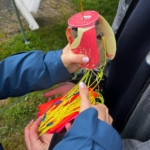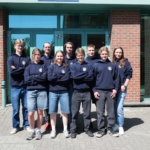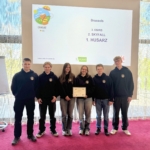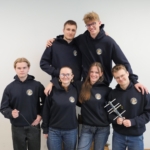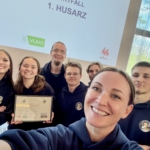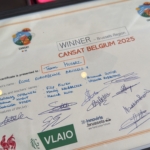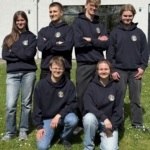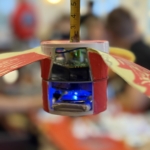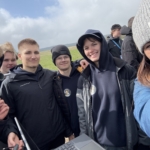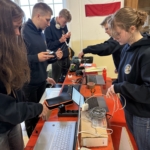CanSat Husarz (EEB1) won 1st place!
This year’s CanSat competition has come to an end, with the finals having taken place from the 24th to the 26th of April in the Belgian Ardennes. The thirty teams from three regions, who qualified for the final stage in previous rounds, spent three days preparing their cans, launching them, and presenting their findings to a jury. Our EEB1 team, Husarz, won the competition in the Brussels region!
What is CanSat?
CanSat is an initiative of the European Space Agency, organised by local governments in European countries. It aims to educate and give students aged 16 to 17 an opportunity to get into physics, computer science and other aspects connected to space missions. In Belgium it is organised by Innoviris in the Brussels region, Vlaio in Flanders and Wallonie in Wallonia. It also has the support of the European Space Education and Research Office. Students have 8 months to develop a working satellite-like device and convince a jury (in two subsequent reports and presentations, which serve as eliminatory phases) it is a worthwhile project. When they do that, they get to see their project launched into the atmosphere to execute its missions.
Every project has a standard set of requirements to fulfil, such as dimensions, weight, operation time and a primary mission. The main requirement is fitting into the footprint of a soda can. This primary mission, which consists of measuring atmospheric variables, like pressure and temperature, is accompanied by a secondary mission, which every team chooses for itself. While choosing it is important to evaluate the scientific worth of the mission, as in how the mission will contribute to science. Also very important is outreach, which serves to further spread curiosity about space and physics and engage younger generations in the science going on right now.
Husarz, who we are:
Our CanSat team started its work at the beginning of October last year, brainstorming how to bring our ambitions to life. It is composed of seven students, Gabriela Dymek, Maciej Kalbarczyk, Helena Kogut, Maciek Kuik, Hubert Odachowski, Mateusz Ostrowski and Filip Piwko. We chose as our secondary mission building two cans in the space of one, to be able to communicate between two devices, and exploring how the Can slows its fall after the launch. A CanSat project cannot work without proper planning and distribution of responsibility, we could only start work after deciding who would be helping with software, mechanical design, and outreach. Next came many tests, ordering components and workshops. We had to build wings capable of slowing one of our Cans to a specific speed, and a container to fit the electronics and antennas for communication. Why did we use wings? A typical CanSat uses a parachute to control its fall, however since we needed two cans to communicate between themselves, we would have to control the fall of two cans. This let us explore a different way of reducing our terminal velocity, and we decided to add a new component to our secondary mission, which was using wings.
By January we had a prototype and had started posting about our mission. Soon after came our first report, in which we had to explain what we were doing, our progress on all aspects of our mission and what the scientific worth of our secondary mission was. After the first report we contacted antenna experts who gave us an idea on how to install our Cans’ antenna, and the Von Karman Institute for fluid dynamics, which helped us with questions about our wing design. All these meetings helped us determine how we’d proceed and gave us insight on how the Cans we were designing would function.
Our second progress report was due in February, and we passed through that one as well, after that came the semifinals. CanSat functions as a scientific competition, so every team must show their merit, what they bring to the table and why they are more prepared than others. To pass through to the finals teams had to give a five-minute presentation, which is much less time. Every member had around fifty seconds to present five months of work, ranging from software design to social media presence. In the end we were one of the ten teams from Brussels who qualified to go to the military base in Elsenborn in the Ardennes to launch our project.
All our progress was facilitated by the three members of last year’s team Szyszka, who had gone through all four stages already, and knew how to manage time and what to prioritise. That’s why CanSat encourages outreach, to give future participants the opportunity of learning from current teams. If you are interested in this type of project, we sincerely encourage you to follow our Instagram (@cansat_eeb1) and YouTube (CanSat Husarz) accounts, and contacting us in case you have any specific questions.
Finals
The finals are divided into three days, the first is consecrated to assembling and certifying the Cans to be launched in a small rocket, the second is the Launchday, which tested months of our hard work, and between that and the presentations in front of a jury, teams are given time to prepare the data received and results obtained from their missions. In the end, there are three winners, one from each Belgian region, and a general Belgian one chosen from the three.
As for our performance: we arrived with our two-part Can ready to assemble, however in order to have as polished a device as possible, we used all the time available, cutting out spare wings and improving our electronics layout, and stiffening the internal structure.
After an almost hiccupless launch we travelled to a hotel in which we’d be giving our presentation to start visualizing the data we got and putting it on a presentation to show the jury. After that, the only thing left was showing what our work had brought us.
The presentation had the same guidelines as the ones given during the semifinals, five minutes per presentation, and certain elements we were required to present. If you are curious about how it went, it is uploaded to YouTube on our channel, you are free to watch and ask your own questions.
We ended up winning the competition in the Brussels region, with a team called the Filter Flyers winning in the Flanders region and the overall Belgian competition, and team Vigilance winning in Wallonia.
Special mentions and final message
We sincerely thank our accompanying teachers, Ms. Rybałtowska and Mr. Jutier, for their guidance, advice and time spent on our project, our school’s physics Lab assistant, Mr. Houben, for his patience towards us and lending us his tools, Prof. Schram from the Von Karman Institute for his insight on the functioning of our Can and Mr. Dombrowski and the UBA radio experts, who helped us with building our antennas.
CanSat is a unique experience, and we wish this article has inspired you to take part in it or follow it more closely!
Useful links:
- https://www.esa.int/Education/CanSat
- https://www.innoviris.brussels/fr/program/cansat-belgium
- https://www.instagram.com/cansat_eeb1/
- https://www.youtube.com/@Hussat2024
KUIK Maciek (UCC-S6PLB)

